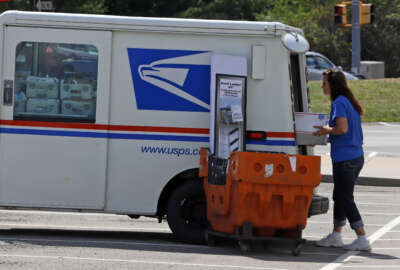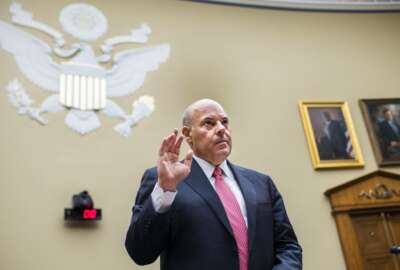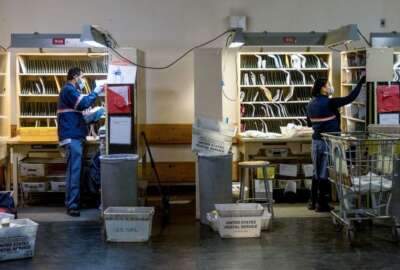Challenge to USPS fleet cost analysis advances to House floor after committee vote
The Postal Service is facing yet another challenge to plans for its next-generation vehicle fleet — this time from Congress.
The Postal Service is facing yet another challenge to plans for its next-generation vehicle fleet — this time from Congress.
Democrats on the House Oversight and Reform Committee on Wednesday approved a bill that would require USPS to conduct a new environmental impact statement (EIS), which accounts for the costs and benefits of electric and gas-powered vehicles in its future fleet.
The Ensuring an Accurate Postal Fleet Electrification Act passed out of committee in a 20-15 vote along party lines, with no Republican member voting for the legislation. The bill now heads to the full House for a floor vote.
Committee Chairwoman Carolyn Maloney (D-N.Y.) said USPS underestimates the benefits of electric vehicles in its current environmental analysis and lowballs the future price of gasoline.
The Government Accountability Office recently found that said USPS used a 2020 gas price in its analysis that now is almost $2 per gallon less than the current national average.
“We are in the middle of a climate crisis. The Postal Service should be leading the charge to reduce carbon emissions and green its fleet. Locking itself into gas-guzzling trucks for at least another two decades is bad for the environment, bad for our health and bad for business,” Maloney said.
USPS spokeswoman Kim Frum said the legislation “takes steps in exactly the wrong financial and operational direction.”
USPS in March spent nearly $3 billion on 50,000 next-generation vehicles as part of its initial order to the vendor Oshkosh Defense. More than 10,000 vehicles as part of that initial order are electric vehicles — more the double the number of EVs the agency expected to purchase.
Frum said the agency’s commitment to electric vehicles “remains ambitious given the pressing vehicle and safety needs of our aging fleet as well as our fragile financial condition.”
“Any legislated delay of this order, which includes contract flexibility to increase vehicle electrification if financial and business use case justifications present themselves, will also have environmental consequences as 30-year old environmentally and employee unfriendly vehicles continue to travel through American neighborhoods, and our purchase of 10,019 electric vehicles is put on hold,” Frum said.
Maloney said USPS is also setting a low bar for fuel efficiency for gas-powered vehicles in its next-generation fleet. Current USPS Long Life Vehicles have an average fuel efficiency of 8.2 miles per gallon and USPS estimates they consume over 97 million gallons of gasoline per year.
The agency expects gas-powered vehicles in its next-generation fleet would get 8.6 miles per gallon with the air conditioning running. Without air conditioning running, they would get 14.7 miles per gallon.
USPS operates a fleet of more than 230,000 vehicles, which makes up about a third of the total federal government fleet.
Committee Ranking Member James Comer (R-Ky.) spoke out against the legislation. He said the bill runs counter to bipartisan USPS reform legislation he championed, which President Joe Biden recently signed into law.
“If you’re talking about disrupting the Postal Service, this bill does it,” Comer said.
Maloney and Comer led efforts in the House to pass the Postal Service Reform Act, which Biden signed on April 6.
Comer said the reform bill focused on improving the agency’s long-term operating model, so USPS can “stop the hemorrhaging of cash” and improve on-time mail delivery.
“The Post Office should be self-sustainable, and it should be able to deliver the mail in a timely manner. This bill is not interested in supporting the Postal Service’s mission to deliver mail effectively and efficiently. It’s not interested in making sure that the current Postal Service employees have safe delivery trucks. It’s not interested in wisely investing taxpayer dollars,” Comer said.
The committee’s vote on the bill marks the largest move from House Democrats to block USPS from moving ahead with a largely gas-powered future fleet.
Maloney, in a hearing last month, said USPS “needs to go back to the drawing board” on the environmental assumptions that underpin its next-generation fleet.
Maloney said a revised environmental analysis would demonstrate that USPS “can and must increase the number of electric vehicles that it purchases.”
Comer, however, said the bill would require USPS to spend more time and money unnecessarily to conduct a new environmental review.
“Restarting this effort would be expensive and forced the Postal Service to rely on their current delivery vehicles to accomplish the primary mission. That’s unacceptable,” Comer said.
Frum said USPS officials have spent thousands of hours on the Environmental Impact Statement for its next-generation delivery vehicle (NGDV) fleet, and that the document meets the agency’s requirements under the National Environmental Policy Act (NEPA).
“It is a thorough, professional record of our efforts to take a hard look at the NGDV’s environmental impacts, consider reasonable alternatives and mitigation, and consult the public and agencies such as [the White House Council on Environmental Quality] and EPA. This is what NEPA requires. It does not mandate particular results or substantive outcomes — NEPA does not require that we select the option with the least environmental impact,” Frum said.
House Democrats have introduced several bills that would give USPS billions of dollars to invest in more electric vehicles and charging infrastructure. The Build Back Better Act would have given the agency $6 billion to spend on an electric fleet, but the legislation doesn’t have enough support from Democrats in the Senate.
USPS is also facing three separate lawsuits over its next-generation fleet. The lawsuits led by 16 states, environmental groups and the United Auto Workers also seek to prevent USPS from taking any further action under its next-generation delivery vehicle contract, until it conducts a more in-depth environmental review.
Postmaster General DeJoy recently said USPS only made a decision so on the 50,000 vehicles it has already purchased — not the full fleet of nearly 200,000 vehicles it expects to buy over the 10-year lifecycle of its contract with Oshkosh Defense.
The more than 10,000 electric vehicles USPS ordered as part of its initial purchase will be on the road by 2026. The agency expects gas-powered next-generation delivery vehicles will arrive on mail routes starting next year.
DeJoy said in a recent interview that said he’s not opposed to electric vehicles, but with an outdated fleet that’s “burning and breaking up every day,” he said USPS, more than anything, needs vehicles that work.
The current USPS fleet of Long Life Vehicles lacks basic features such as airbags and anti-lock brakes.
“From a green perspective, we pay attention to this stuff, to the extent that our budget enables us. It’s not my primary mission. My primary mission is to deliver to 161 million addresses and cover my costs,” DeJoy said.
DeJoy said the agency has about two years until it has to make its next decision on how many additional electric vehicles it will purchase from Oshkosh Defense.
Committee approves USPS facilities oversight bill
The committee also approved the legislation that would guarantee congressional oversight of USPS facilities.
The Ensuring Oversight Access at the Postal Service Act clarifies existing law and Office of Special Counsel guidance for USPS, and would prevent the agency from preventing any member of Congress from visiting USPS facilities for official purposes.
The bill’s sponsor, Government Operations Subcommittee Chairman Gerry Connolly (D-Va.), said USPS officials denied his request in October 2002 to tour the Merrifield Postal Distribution Center, located in the district he represents.
USPS policy provided to Connolly states the Hatch Act prohibits members of Congress from visiting postal facilities in the 45 days leading up to a primary or general election.
“The implication seemed to be that either I or the Postal Service employees would be unable to refrain from launching into partisan political activities in our visit,” Connolly said.
USPS officials followed up by telling Connolly the agency policy was approved by the Office of Special Counsel.
OSC, however, wrote a letter to Maloney stating that the Hatch Act does not prevent members of Congress from executing their oversight duties and responsibilities through tours or other actions.
Connolly said his bill would make it clear to USPS that members of Congress should be able to oversight work, regardless of the timing.
“This responsibility does not cease merely because an election is approaching. Oversight is a fundamental responsibility and duty of congress. No agency — or in this case, no independent establishment of the executive branch — shall tell the first branch of government when and where they can conduct oversight,” Connolly said.
Copyright © 2025 Federal News Network. All rights reserved. This website is not intended for users located within the European Economic Area.
Jory Heckman is a reporter at Federal News Network covering U.S. Postal Service, IRS, big data and technology issues.
Follow @jheckmanWFED






